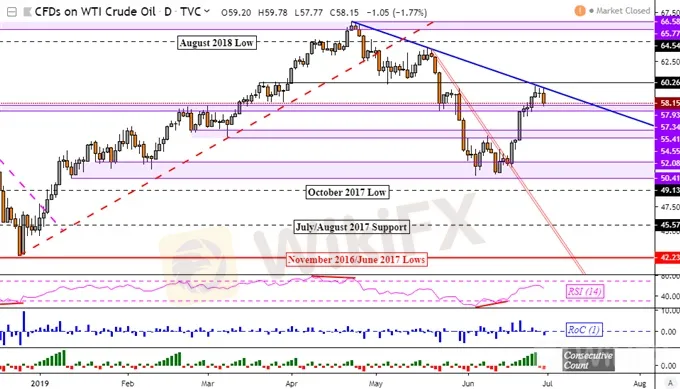简体中文
繁體中文
English
Pусский
日本語
ภาษาไทย
Tiếng Việt
Bahasa Indonesia
Español
हिन्दी
Filippiiniläinen
Français
Deutsch
Português
Türkçe
한국어
العربية
Yen May Sink as US-China Restart Trade Talks, Can Crude Oil Rise?
Abstract:The Japanese Yen may weaken as markets digest US-China restarting trade talks after the G20 Summit. Will this offset crude oil price declines as EU cooled Iran supply disruption fears?
Asia Pacific Market Open Talking Points
Japanese Yen may weaken as US-China restart trade talks from G20 Summit
Can crude oil prices rise, countering EU cooling Iran supply disruption fears?
S&P 500 futures, Nikkei 225 may rally alongside pro-risk AUD and NZD
Not sure where the Japanese Yen is going next? We just released the third quarter JPY fundamental and technical forecast!
Yen May Weaken as the US, China Agree to Restart Trade Talks From G20 Summits
The anti-risk Japanese Yen may weaken at the beginning of the new week as markets digest a US-China trade truce. From this weekends G20 Summit, US President Donald Trump withheld raising roughly an additional $300b in Chinese import tariffs. From here, the US and China will restart trade talks as Mr Trump said that the latter nation will purchase additional agricultural goods from the former.
While equities such as the Nikkei 225 may rally at open, it is unclear if there is enough fundamental support for follow-through. For one thing, the current 25% tariff rate on roughly $250b Chinese goods exported to the US still remains and anticipation of a trade truce helped stocks rally this past week to an extent. Then, it remains to be seen if this can pour cold water on aggressive Fed rate cut bets. That may sink sentiment.
Crude Oil Sunk as EU Launched INSTEX
Such anticipation in the lead-up to this weekend‘s G20 Summit left the US Dollar ignoring the latest gauge of the Fed’s preferred measure of inflation (core PCE), which clocked in at 1.6% y/y in May versus 1.5% expected. The Canadian Dollar also paid not much attention to softer than expected local GDP data where growth printed 1.5% y/y versus 1.6% anticipated.
The same could not be said for crude oil when the European Union launched INSTEX, the mechanism “aimed at facilitating legitimate business with Iran”. It serves as a way for Iran to sidestep sanctions the US imposed on them. Oil sunk on the announcement as this cooled supply disruption concerns. But, this may come back to haunt the EU and local markets if US President Donald Trump retaliates.
Crude Oil Technical Analysis
Focusing on technical analysis, crude oil prices turned lower on Friday after the falling trend line from April tamed its uptrend as anticipated. The rise to the trend line was initiated by an upside breakout through the falling resistance line from May (red line below). If near-term support holds, keep an eye on resistance at 60.26 just above the trend line. Confirming a close above it paves the way for uptrend extension.
Crude Oil Daily Chart

*Charts Created in TradingView
FX Trading Resources
See how oil is viewed by the trading community at the DailyFX Sentiment Page
See our free guide to learn what are the long-term forces driving crude oil prices
See our study on the history of trade wars to learn how it might influence financial markets!
Disclaimer:
The views in this article only represent the author's personal views, and do not constitute investment advice on this platform. This platform does not guarantee the accuracy, completeness and timeliness of the information in the article, and will not be liable for any loss caused by the use of or reliance on the information in the article.
Read more

Upbeat U.S. GDP Spurs Dollar Strength
The U.S. GDP released yesterday surpassed market expectations, which has tempered some speculation about a Fed rate cut and spurs dollar's strength.

Oil Price Soar on Geopolitical Tension
Geopolitical tensions in both the Middle East and Eastern Europe have escalated, oil prices surged nearly 3% in yesterday's session. creating significant unease in the broader financial markets.

KVB Market Analysis | 23 August: JPY Gains Ground Against USD as BoJ Signals Possible Rate Hike
JPY strengthened against the USD, pushing USD/JPY near 145.00, driven by strong inflation data and BoJ rate hike expectations. Japan's strong Q2 GDP growth added support. However, USD gains may be limited by expectations of a Fed rate cut in September.

BoJ Holds Firm on Tightening Path Fuels Yen
The Bank of Japan (BoJ) remains on course with its monetary tightening policy, according to the BoJ Chief, following his hearing at the Japan Lower House.
WikiFX Broker
Latest News
Two Californians Indicted for $22 Million Crypto and NFT Fraud
RM62k Lost Investment Scam After Joining XRP Community Malaysia on Telegram
Victims of Financial Fraud in France Suffer Annual Losses of at Least €500 Million
WikiFX Review: Is Ultima Markets Legit?
Colorado Duo Accused of $8M Investment Fraud Scheme
What Impact Does Japan’s Positive Output Gap Have on the Yen?
Macro Markets: Is It Worth Your Investment?
Trading is an Endless Journey
Malaysia Pioneers Zakat Payments with Cryptocurrencies
FCA's Warning to Brokers: Don't Ignore!
Currency Calculator


